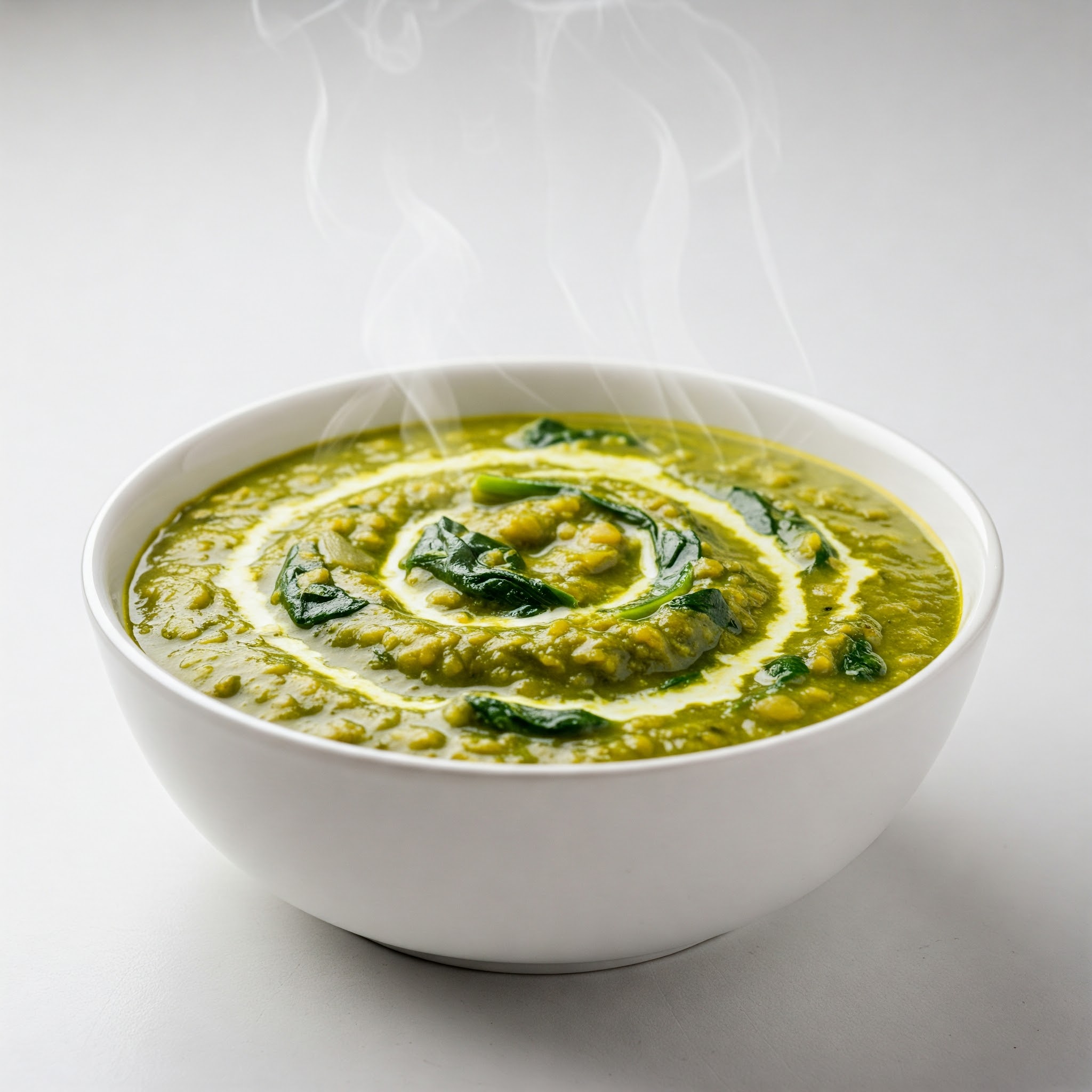
Dal Palak Recipe
Dal Palak is a nutritious and flavorful Indian dish that combines lentils (dal) with spinach (palak), seasoned with aromatic spices. Here’s a detailed description of the Dal Palak recipe:
Appearance:
Dal Palak has a vibrant green color, with tender spinach leaves and cooked lentils visible in the dish. It is often garnished with a drizzle of ghee (clarified butter) or cream, adding richness and enhancing its appearance.
Aroma:
The aroma of Dal Palak is aromatic and earthy, filled with the fragrance of cumin seeds, garlic, and ginger. The tempering of spices like cumin seeds and dried red chilies enhances the dish’s aroma, creating an inviting scent.
Flavor Profile:
Dal Palak boasts a balanced flavor profile where the earthiness of spinach complements the nuttiness of lentils. The dish begins with cooking lentils (commonly yellow moong dal or toor dal) until they are soft and creamy. Meanwhile, spinach leaves are blanched and pureed to a smooth consistency. Onions, tomatoes, garlic, ginger, and green chilies are sautéed in ghee or oil until they turn golden brown. A blend of ground spices including turmeric, cumin powder, coriander powder, and garam masala is added to the tempering, infusing the dal with layers of flavor. The pureed spinach and cooked lentils are then combined and simmered together to allow the flavors to meld.
Texture:
The texture of Dal Palak is smooth and creamy, with the lentils and spinach blending together seamlessly. The dish offers a comforting mouthfeel with each spoonful, with the tender spinach leaves adding a delicate texture.
Cultural Significance:
Dal Palak holds cultural significance in Indian cuisine as a nutritious and wholesome dish. It is often prepared as part of everyday meals and is valued for its health benefits, providing essential nutrients from lentils and spinach.
Serving and Enjoyment:
Dal Palak is traditionally served hot as a main course dish, accompanied by steamed rice or roti (Indian flatbread). It can be garnished with a dollop of yogurt or cream, a squeeze of lemon juice, and additional chopped cilantro leaves for freshness. Dal Palak pairs well with a side of pickle or papad (crispy Indian crackers), providing a balanced and satisfying meal experience.
Conclusion:
Dal Palak is a beloved dish that exemplifies the simplicity and nutrition of Indian home cooking. Its vibrant green color, aromatic flavors, and creamy texture make it a favorite among food enthusiasts seeking a hearty and wholesome meal. Whether enjoyed at a local eatery or prepared at home, Dal Palak invites you to savor its humble ingredients and the cultural heritage it represents in Indian cuisine.
Instruments Required:
1. **Pressure Cooker or Pot**: For cooking lentils (dal) and spinach.
2. **Pan or Kadhai**: For tempering and sautéing spices.
3. **Stirring Spoon**: For stirring and mixing ingredients.
4. **Knife and Cutting Board**: For chopping onions, tomatoes, spinach, and garnishes.
5. **Measuring Spoons and Cups**: For accurate measurements of ingredients.
Ingredients:
– 1 cup Toor Dal (Pigeon Pea Lentils), washed and soaked for 30 minutes
– 3 cups Water (for pressure cooking dal)
– 2 cups Spinach Leaves, washed and chopped
– 2 tbsp Ghee or Oil
– 1 tsp Cumin Seeds
– 1 Onion, finely chopped
– 2 Tomatoes, finely chopped
– 2 Green Chilies, slit lengthwise
– 1 inch Ginger, grated
– 4-5 Garlic cloves, minced
– 1/2 tsp Turmeric Powder
– 1 tsp Red Chili Powder
– 1 tsp Coriander Powder
– Salt to taste
– 1/2 tsp Garam Masala Powder
– 1 tbsp Lemon Juice
– Chopped Coriander Leaves for garnish
Instructions:
Cooking Lentils (Dal):
1. In a pressure cooker, add the soaked toor dal along with 3 cups of water.
2. Pressure cook the dal for 3-4 whistles or until it is soft and cooked through.
3. Once the pressure releases naturally, open the cooker and mash the dal using the back of a spoon or a potato masher. Set aside.
Cooking Spinach:
1. In a separate pot, bring water to a boil.
2. Add chopped spinach leaves to the boiling water and blanch them for 2-3 minutes.
3. Drain the blanched spinach leaves and rinse them under cold water to retain their green color.
4. Transfer the blanched spinach to a blender or food processor and blend into a smooth puree. Set aside.
Making Dal Palak:
1. Heat ghee or oil in a pan or kadhai over medium heat.
2. Add cumin seeds to the hot ghee or oil. Let them crackle.
3. Add finely chopped onions to the pan and sauté until they turn translucent.
4. Add minced garlic, grated ginger, and slit green chilies to the pan. Sauté for a minute until aromatic.
5. Add finely chopped tomatoes to the pan and cook until they become soft and mushy.
6. Add turmeric powder, red chili powder, and coriander powder to the pan. Mix well and cook for a minute.
7. Now, add the cooked and mashed dal to the pan. Mix everything together until well combined.
8. Add salt to taste and adjust the consistency of the dal by adding water if needed. Bring the dal to a gentle boil.
9. Add the spinach puree to the dal and mix well.
10. Let the dal simmer for 5-7 minutes, allowing the flavors to blend and the spinach to cook through.
11. Stir in garam masala powder and lemon juice. Mix well.
Serving Size:
This recipe makes approximately 4 servings.
Serving:
1. Transfer the prepared Dal Palak to serving bowls.
2. Garnish with chopped coriander leaves.
3. Serve hot with steamed rice, roti, or naan.
4. Enjoy your nutritious and flavorful Dal Palak!
Cooking Time:
The total time required for cooking Dal Palak is approximately 45-50 minutes, including preparation, cooking dal and spinach, and tempering spices. Adjust the spice levels according to your taste preferences.